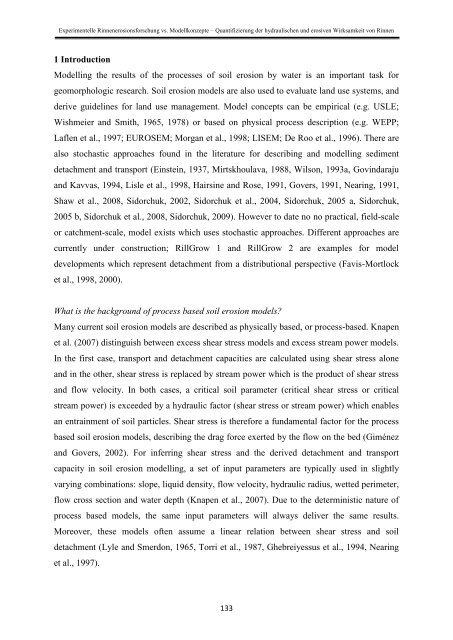Stefan Wirtz Vom Fachbereich VI (Geographie/Geowissenschaften ...
Stefan Wirtz Vom Fachbereich VI (Geographie/Geowissenschaften ...
Stefan Wirtz Vom Fachbereich VI (Geographie/Geowissenschaften ...
Create successful ePaper yourself
Turn your PDF publications into a flip-book with our unique Google optimized e-Paper software.
Experimentelle Rinnenerosionsforschung vs. Modellkonzepte – Quantifizierung der hydraulischen und erosiven Wirksamkeit von Rinnen<br />
1 Introduction<br />
Modelling the results of the processes of soil erosion by water is an important task for<br />
geomorphologic research. Soil erosion models are also used to evaluate land use systems, and<br />
derive guidelines for land use management. Model concepts can be empirical (e.g. USLE;<br />
Wishmeier and Smith, 1965, 1978) or based on physical process description (e.g. WEPP;<br />
Laflen et al., 1997; EUROSEM; Morgan et al., 1998; LISEM; De Roo et al., 1996). There are<br />
also stochastic approaches found in the literature for describing and modelling sediment<br />
detachment and transport (Einstein, 1937, Mirtskhoulava, 1988, Wilson, 1993a, Govindaraju<br />
and Kavvas, 1994, Lisle et al., 1998, Hairsine and Rose, 1991, Govers, 1991, Nearing, 1991,<br />
Shaw et al., 2008, Sidorchuk, 2002, Sidorchuk et al., 2004, Sidorchuk, 2005 a, Sidorchuk,<br />
2005 b, Sidorchuk et al., 2008, Sidorchuk, 2009). However to date no no practical, field-scale<br />
or catchment-scale, model exists which uses stochastic approaches. Different approaches are<br />
currently under construction; RillGrow 1 and RillGrow 2 are examples for model<br />
developments which represent detachment from a distributional perspective (Favis-Mortlock<br />
et al., 1998, 2000).<br />
What is the background of process based soil erosion models?<br />
Many current soil erosion models are described as physically based, or process-based. Knapen<br />
et al. (2007) distinguish between excess shear stress models and excess stream power models.<br />
In the first case, transport and detachment capacities are calculated using shear stress alone<br />
and in the other, shear stress is replaced by stream power which is the product of shear stress<br />
and flow velocity. In both cases, a critical soil parameter (critical shear stress or critical<br />
stream power) is exceeded by a hydraulic factor (shear stress or stream power) which enables<br />
an entrainment of soil particles. Shear stress is therefore a fundamental factor for the process<br />
based soil erosion models, describing the drag force exerted by the flow on the bed (Giménez<br />
and Govers, 2002). For inferring shear stress and the derived detachment and transport<br />
capacity in soil erosion modelling, a set of input parameters are typically used in slightly<br />
varying combinations: slope, liquid density, flow velocity, hydraulic radius, wetted perimeter,<br />
flow cross section and water depth (Knapen et al., 2007). Due to the deterministic nature of<br />
process based models, the same input parameters will always deliver the same results.<br />
Moreover, these models often assume a linear relation between shear stress and soil<br />
detachment (Lyle and Smerdon, 1965, Torri et al., 1987, Ghebreiyessus et al., 1994, Nearing<br />
et al., 1997).<br />
133
















